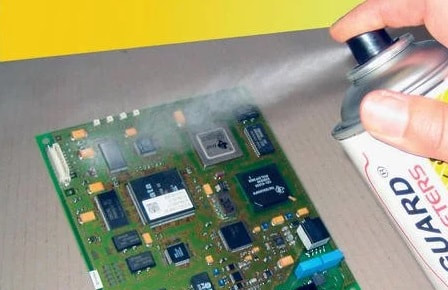Conformal coating is a protective material applied to electronic circuitry to protect it from environmental factors such as moisture, dust, chemicals, and temperature extremes. Applying conformal coating by spray and aerosol methods is a common practice in the electronics industry. Here's an overview of the process for both methods:
1. Surface Preparation:
- Before applying conformal coating, it's crucial to ensure that the surfaces to be coated are clean and free from contaminants such as dust, oils, and residues.
- Cleaning methods may include using solvents, brushes, or specialized cleaning equipment.
- Components that should not be coated, such as connectors, switches, and certain areas of the board, are often masked using tapes or liquid masking materials.
- Choose the appropriate conformal coating material based on the specific requirements of the application and the environmental conditions the electronics will be exposed to.
- Common types include acrylics, urethanes, silicones, and epoxies.
- Some conformal coatings come as a two-part system that needs to be mixed before application. Follow the manufacturer's instructions for proper mixing ratios and procedures.
- Using a spray gun or automated spray system, the conformal coating is evenly applied to the surface of the PCB (Printed Circuit Board).
- The spray gun should be held at an optimal distance and moved at a consistent speed to ensure uniform coverage.
- Conformal coating in aerosol form is available in cans with a nozzle for direct application.
- Ensure the aerosol is shaken well before use to mix the coating material properly.
- Allow the conformal coating to cure or dry based on the manufacturer's recommendations. This may involve air drying, heat curing, or UV curing depending on the type of coating used.
- After the conformal coating has cured, inspect the coated surface for uniformity, coverage, and the absence of defects.
- Special attention should be given to areas near masked components to ensure there are no coating bridges or voids.
- Perform electrical testing to ensure that the conformal coating has not adversely affected the functionality of the electronic components.
- Remove any masking materials that were applied before coating.
- Conduct a final inspection to ensure that the conformal coating meets the desired standards and provides the necessary protection.
As this is a semi-skilled process, training is vital for a consistent process. Following proper procedures and guidelines from the conformal coating material manufacturer is essential to achieve optimal results and ensure the reliability of the coated electronic assemblies.

